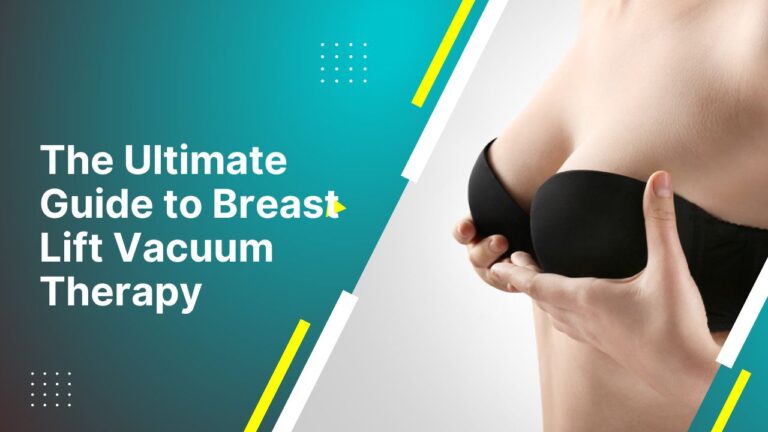A breast lift, also known as mastopexy, is a popular plastic surgery procedure that raises and firms the breasts. During a breast lift, excess skin is removed, and the remaining breast tissue is reshaped to make the breasts perkier.
Many women consider getting a breast lift to restore a more youthful breast contour after pregnancy. Weight loss or ageing takes a toll. But one common concern is – can a breast lift cause cancer?
Let’s take a closer look at the safety of breast lifts and the risk of developing breast cancer after this procedure.
What is a Breast Lift?
A breast lift, or mastopexy, is a surgical procedure to raise and reshape sagging breasts. It aims to accomplish the following aesthetic goals:
Book A Consultation With Dr Tarek Bayazid
Top-rated Plastic Surgeon For Breast Lift in Dubai
Installment Plan Available
- Lift the breast mound higher on the chest wall for a perkier, more youthful position
- Tighten loose, stretched skin to smooth the breast contours
- Reshape the breast tissue for better projection and proportion
- Reduce enlarged areolas by excising skin at the perimeter
During a breast lift, excess skin is removed, and the remaining tissue is sutured into a lifted position. The nipple and areola are also repositioned higher to complete the reshaping.
Reasons and Procedure for Choosing a Breast Lift
Reasons women choose to get a breast lift include:
- Sagging breasts, often after pregnancy, weight loss, or ageing
- Stretched skin with enlarged areolas
- Breasts that lack firmness and have lost volume
During a breast lift, your plastic surgeon will make small incisions and remove excess skin, tissue, and fat. The remaining tissue will be gathered to reshape and support the new breast contour. Breast lift surgery can be paired with breast augmentation or breast reduction surgery, too.
Does Breast Lift Cause Cancer?
There is no evidence that a breast lift causes or increases the risk of breast cancer. Breast lift surgery only removes excess skin and reshapes sagging breast tissue. It does not alter breast cell DNA or trigger cancerous changes.
So, the good news is – breast lift surgery does not cause breast cancer.
Several large clinical studies of women undergoing cosmetic breast surgery found no increased risk of developing breast cancer compared to women who did not have surgery.
A breast lift, similar to a breast reduction or breast augmentation, is considered a safe, non-cancer-causing breast procedure by plastic surgeons.
Does Breast Lift Surgery Affect Breast Cancer Risks?
Breast lift surgery itself does not increase the chances of developing breast cancer. In fact, some surgeons say the breast tissue is healthier after mastopexy since the remaining tissue is firmer and receives a better blood supply.
However, there are a few things to keep in mind about existing breast cancer risks with mastopexy:
Pre-Existing Conditions
- Women should inform their surgeons if they have a family history of breast cancer, carry the BRCA breast cancer gene, or have other high-risk factors. Individual risks will be assessed.
Implants and Breast Cancer
- Breast lifts are sometimes combined with implants. Research on implants and cancer risks has shown conflicting results, with most studies finding implants do not significantly increase breast cancer risk.
Limitations of Mammograms
- After breast surgery, like lifts, scar tissue in the breasts may potentially hide tumours and early signs of cancer. It can limit the accuracy of mammograms. Patients should inform radiologists about any surgeries.
As with any surgery, know your personal health history and talk to your doctors when considering the pros and cons. But breast lifts themselves are not thought to increase breast cancer likelihood.
Other Potential Complications from Breast Lift Surgery
While a breast lift does not cause cancer, as with any major surgery, there are still risks to consider, including:
- Temporary swelling, bruising, numbness
- Permanent scarring around the areola and breast area
- Asymmetry in breast shape and size of breasts were different sizes before surgery
- Loss of sensation in the nipples or breasts
- Infection or bleeding complications during/after surgery
Results also may not be permanent. Pregnancy, weight changes, and ageing can counteract a breast lift so that breasts may eventually sag again. Discuss risks thoroughly with your surgeon before deciding if a lift is right for you.
Breast Lift Techniques
There are a few different breast lift surgery techniques your plastic surgeon may use:
- Crescent lift: Removes a small crescent of skin above the areola—minimal scarring.
- Circumareolar lift: Cuts around the areola to lift breasts.
- Vertical lift: An anchor-shaped incision around the areola and down to the breast crease.
- Wise pattern lift: The most invasive lift technique that removes lots of excess skin for severely sagging breasts. Creates an anchor-shaped scar.
The best technique will depend on factors like the amount of sagging, skin tone, breast shape and size, and patient preferences.
Finding a Qualified Breast Lift Surgeon
You must choose an experienced, board-certified plastic surgeon to perform your breast lift. Prospective surgeons should:
- Be certified by the American Board of Plastic Surgery with proper medical licensing
- Have advanced surgical training in cosmetic breast procedures
- Listen to your goals and offer realistic outcomes
- Show you before/after photos of their lift mastopexy results
- Operate out of an accredited surgical facility
During consultations, ask how many lift procedures your surgeon has performed. More experience means fewer risks plus better aesthetic results.
Preparing for Breast Lift Surgery
To achieve optimal results from breast lift surgery, here are some important do’s and don’ts:
Do:
- Get medical clearance for surgery from your doctor
- Take at least two weeks off work to recover
- Arrange for transportation to/from surgery
- Stock up on recommended medication, gauze, cold compresses
- Follow all pre/post-op instructions carefully
Don’t:
- Take aspirin, anti-inflammatory meds, or certain vitamins/herbs before surgery per surgeon protocol.
- Smoke or consume alcohol for a minimum of 2 weeks before and after
- Over-exert yourself physically during initial recovery
Following proper pre/post-surgery protocols lowers your risk for bleeding, poor wound healing, infections, and other complications after a breast lift.
Recovery After Breast Lift Surgery
Be prepared that healing will take time after a breast lift. Typical recovery includes:
| Timeline | Recovery Milestones | Tips |
| 1-2 days | Hospital stay if you have surgical drains | Use cold compresses for swelling |
| 1-2 weeks | Off-work and minimal activity | Take prescribed medications exactly as directed |
| Two weeks | Stitches removed | Attend all follow-up appointments |
| Six weeks | Swelling and bruising resolves | Do not lift your arms overhead or exercise |
| 3-6 months | Final shape and scars form | Ask the surgeon when it is safe to resume workouts |
Caring for Breast Lift Results Long-Term
To enjoy beautiful, lifted breasts for years after your breast lift, be sure to:
| Method | How It Helps | Frequency |
| Silicone scar sheets | Minimises scar appearance | Wear daily |
| Scar massage | Keeps scars smooth | Massage frequently |
| Sun protection | Prevents dark scarring | Use SPF 30+ daily |
| Supportive bras | Maintain breast shape | Wear bras round the clock for 6+ weeks |
| Stable weight | Preserves lift results | Maintain a steady, healthy weight |
| Breast self-exams | Catch any changes promptly | Check breasts monthly |
While future pregnancies or weight fluctuations may affect results somewhat, you’ll still benefit from fuller, firmer breasts from your lift procedure.
In conclusion, the concern ‘Can a breast lift cause cancer?’ is largely unfounded. Current medical evidence shows no direct link between breast lift procedures and an increased risk of cancer. It’s essential for individuals to consult with healthcare professionals for personalised advice and to understand all aspects of the procedure.
If your breasts have lost volume firmness or developed severe sagging, a mastopexy can restore a pert, youthful breast contour. Be sure to select an experienced plastic surgeon and follow all pre and post-op protocols.
For beautiful, vibrant shaping results, consider a breast lift from an expert like Dr Tarek Bayazid, voted the best plastic surgeon in Dubai. His artistic talent plus expertise in advanced techniques like the deep plane facelift and composite lift mean optimal, natural-looking outcomes.
Book a consultation to meet with Dr. Bayazid. He will assess your needs and explain options for achieving your cosmetic goals through a customised treatment plan.
FAQs – Breast Lift & Cancer Risk:
Can a vampire breastlift cause cancer?
No, a vampire lift uses your plasma-rich platelet blood extract. It cannot cause breast cancer.
Can breastlift surgery cause cancer?
No. Multiple medical studies confirm breast lifts do not cause or increase breast cancer risk for most women.
Does breast lift cause cancer?
Breast lift surgery is not considered a risk factor for developing breast cancer by the American Society of Plastic Surgeons and other authorities. Multiple studies found no cancer link.
Can I just remove loose skin without implants?
Yes, a breast lift repositions breast tissue for added firmness. Implants are optional if you only want small increases in breast size.
How long do breast lift results last?
When performed by an experienced, board-certified plastic surgeon, lift results can last 5-10 years or longer in women with stable weights.
Can a lift fix stretch areolas?
Yes, excess skin around the areolas can be excised and tightened during a doughnut lift around the areola. Position and size can be corrected.







